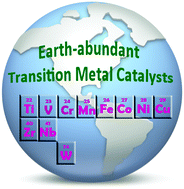The recent development of efficient Earth-abundant transition-metal nanocatalysts
Abstract
Whereas noble metal compounds have long been central in catalysis, Earth-abundant metal-based catalysts have in the same time remained undeveloped. Yet the efficacy of Earth-abundant metal catalysts was already shown at the very beginning of the 20th century with the Fe-catalyzed Haber–Bosch process of ammonia synthesis and later in the Fischer–Tropsch reaction. Nanoscience has revolutionized the world of catalysis since it was observed that very small Au nanoparticles (NPs) and other noble metal NPs are extraordinarily efficient. Therefore the development of Earth-abundant metals NPs is more recent, but it has appeared necessary due to their “greenness”. This review highlights catalysis by NPs of Earth-abundant transition metals that include Mn, Fe, Co, Ni, Cu, early transition metals (Ti, V, Cr, Zr, Nb and W) and their nanocomposites with emphasis on basic principles and literature reported during the last 5 years. A very large spectrum of catalytic reactions has been successfully disclosed, and catalysis has been examined for each metal starting with zero-valent metal NPs followed by oxides and other nanocomposites. The last section highlights the catalytic activities of bi- and trimetallic NPs. Indeed this later family is very promising and simultaneously benefits from increased stability, efficiency and selectivity, compared to monometallic NPs, due to synergistic substrate activation.



 Please wait while we load your content...
Please wait while we load your content...